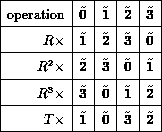We have already obtained the two ideal tiling (6), (7)
of order N=4 without explanations in previous sections.
In order to confirm
whether or not the two are all of the possibly
independent tiling, we need to investigate the characteristic
of pair-symmetrical tiling.
Obviously, we can get the four different tiling patterns from
the ideal tiling (1) by the rotations R which are
![]() ,
, ![]() ,
, ![]() and
and ![]() (see appendix.)
We will describe them shortly by
(see appendix.)
We will describe them shortly by
![]() .
We adopt transposition T and rotation R as a symmetrical transformation
operators
.
We adopt transposition T and rotation R as a symmetrical transformation
operators ![]() in (14).
Since
in (14).
Since ![]() ,
, ![]() and
and ![]() , it is derived that
, it is derived that
![]() and
and ![]() .
Here we should note the transposition T does not satisfy the
association low with rotational operators. E.g.,
.
Here we should note the transposition T does not satisfy the
association low with rotational operators. E.g.,
![]() , but
, but ![]() .
The operators satisfy the following operational table.
.
The operators satisfy the following operational table.

According to the table, we can categorize the ![]() pairs of tiling patterns into
{
pairs of tiling patterns into
{ ![]() ,
, ![]() ,
,
![]() ,
,
![]() ,
, ![]() ,
,
![]() ,
, ![]() ,
,
![]() }
and {
}
and { ![]() ,
, ![]() ,
,
![]() ,
, ![]() }, since
}, since

and

Simply, the above categories can be rewritten by
![]()
and
![]()
These patterns ![]() and
and ![]() are not expressed by any symmetrical
transformation of each other. The symmetrical transformations
of these patterns cover all possible 12 pairs of pair-symmetrical
tiling patterns.
Therefore, the independent tiling patterns in N=4 are given by
are not expressed by any symmetrical
transformation of each other. The symmetrical transformations
of these patterns cover all possible 12 pairs of pair-symmetrical
tiling patterns.
Therefore, the independent tiling patterns in N=4 are given by
![]()
and
![]()
based on conjecture 1 (in the case N=4, it is satisfiable theorem).
These tiling patterns correspond to ![]() ,
, ![]() in
(11) and (12).
Since
in
(11) and (12).
Since ![]() ,
, ![]() are not
given by any (N-let-) symmetrical transformation of each other,
we call such independent tiling patterns "fundamental tilings".
are not
given by any (N-let-) symmetrical transformation of each other,
we call such independent tiling patterns "fundamental tilings".